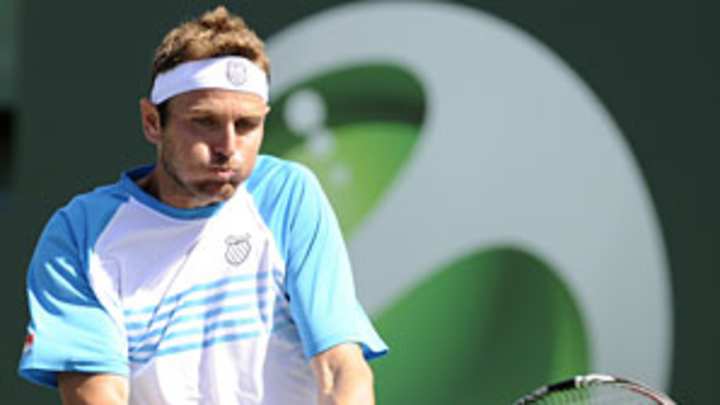Best of Three: Miami Masters going swimmingly for overlooked Fish

1. Fishing for compliments:Mardy Fish has always had a certain "Fifth Beatle" status in American tennis. He was never Andy Roddick, never James Blake, never the Bryan Brothers. He suffered a string of injuries. He conducted himself with a soft-spoken simplicity that perhaps made him "boring" in the eyes of marketers and promoters. But, obscured by others, he's quietly put together an awfully solid career, that included a win on hard courts over Roger Federer. And though Fish jokes that he's now a doubles specialist, he's not done winning quite yet. As Roddick entertained Terrell Owens and played H-O-R-S-E against Dwyane Wade last weekend in Key Biscayne, Fish beat a suddenly struggling Andy Murray in one of the bigger upsets of 2010. (Oli Rochus's takedown of Novak Djokovic last weekend rates up there as well.) Fish prevailed with a solid, comprehensive performance that included some brilliant shotmaking and unflustered serving. Fish may be 28, but those big chunks of time spent on the injured reserve may buy him some years on the back end of his career.
2. Allez Cat:Justine Henin may have needed a wild card to enter the Sony Ericsson draw. But is there really any doubt she's a top-five player? After a disappointing outing in Indian Wells, Henin rebounded nicely last week, beating Elena Dementieva for the second time in 2010 and, relegated to the grandstand court, scoring a solid follow-up win over Dominika Cibulkova on Sunday. While she hasn't shaken off all the rust, she still plays singular artistic tennis and still plays as well as anyone under pressure not named Serena Williams. Will she get back to where she once belonged, winning majors and taking down Serena Williams? Who knows? For now, let's be thankful she's back in the cast.
3. Beyond a reasonable doubt: As is the case in most sports, drug testing in tennis is a messy business filled with controversy. (And that's more than a decade after Andre Agassi duped a tribunal into believing his positive result for crystal meth use was inadvertent.) Of all the various anti-doping bans handed out to tennis players in recent years, shockingly few have been for performance-enhancing substances. The cases of Martina Hingis and Richard Gasquet were, circumstantially, remarkably similar; yet the consequences were remarkably different. Players say the testing is too intrusive and rigorous. Other observers say the testing is isn't rigorous enough, as evidenced by how many players missed an out-of-competition test in 2009 -- information that was once posted on the ITF website and is no longer accessible.
Yet last week, we may have gotten the most convincing evidence that performance-enhancing drugs have seeped into tennis. Wayne Odesnik, an American ranked in the top 100 -- a journeyman, but not exactly a no-name -- pleaded guilty to smuggling eight vials of human growth hormone in his luggage as he tried to enter Australia earlier this year. There's no contested test result, no conflicting B-sample, no procedural question, no hair-loss medication (or cocaine) that might be illegal and banned but doesn't undercut competition. What we have here is unambiguous: a guilty plea with respect to possession of a banned performance-enhancing agent. Odesnik faces the prospect of a two-year ban. Beyond that, he may, sadly, have profferred the most convincing evidence yet that tennis isn't as clean as we'd like to think.

Jon Wertheim is a senior writer for Sports Illustrated and has been part of the full-time SI writing staff since 1997, largely focusing on the tennis beat , sports business and social issues, and enterprise journalism. In addition to his work at SI, he is a correspondent for "60 Minutes" and a commentator for The Tennis Channel. He has authored 11 books and has been honored with two Emmys, numerous writing and investigative journalism awards, and the Eugene Scott Award from the International Tennis Hall of Fame. Wertheim is a longtime member of the New York Bar Association (retired), the International Tennis Writers Association and the Writers Guild of America. He has a bachelor's in history from Yale University and received a law degree from the University of Pennsylvania. He resides in New York City with his wife, who is a divorce mediator and adjunct law professor. They have two children.
Follow jon_wertheim